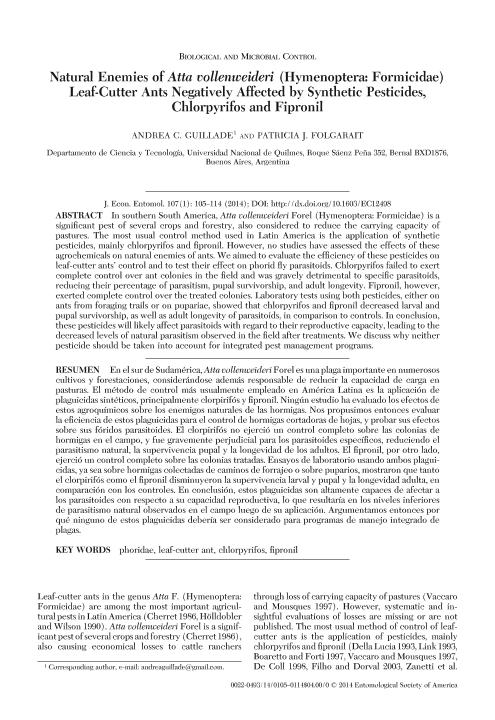Artículo
Natural enemies of Atta vollenweideri (Hymenoptera: Formicidae) leaf-cutter ants negatively affected by synthetic pesticides, chlorpyrifos and fipronil
Fecha de publicación:
02/2014
Editorial:
Oxford University Press
Revista:
Journal of Economic Entomology
ISSN:
0022-0493
Idioma:
Inglés
Tipo de recurso:
Artículo publicado
Clasificación temática:
Resumen
In southern South America, Atta vollenweideri Forel (Hymenoptera: Formicidae) is a significant pest of several crops and forestry, also considered to reduce the carrying capacity of pastures. The most usual control method used in Latin America is the application of synthetic pesticides, mainly chlorpyrifos and fipronil. However, no studies have assessed the effects of these agrochemicals on natural enemies of ants. We aimed to evaluate the efficiency of these pesticides on leaf-cutter ants' control and to test their effect on phorid fly parasitoids. Chlorpyrifos failed to exert complete control over ant colonies in the field and was gravely detrimental to specific parasitoids, reducing their percentage of parasitism, pupal survivorship, and adult longevity. Fipronil, however, exerted complete control over the treated colonies. Laboratory tests using both pesticides, either on ants from foraging trails or on pupariae, showed that chlorpyrifos and fipronil decreased larval and pupal survivorship, as well as adult longevity of parasitoids, in comparison to controls. In conclusion, these pesticides will likely affect parasitoids with regard to their reproductive capacity, leading to the decreased levels of natural parasitism observed in the field after treatments. We discuss why neither pesticide should be taken into account for integrated pest management programs.
Palabras clave:
CHLORPYRIFOS
,
FIPRONIL
,
LEAF-CUTTER ANT
,
PHORIDAE
Archivos asociados
Licencia
Identificadores
Colecciones
Articulos(SEDE CENTRAL)
Articulos de SEDE CENTRAL
Articulos de SEDE CENTRAL
Citación
Guillade, Andrea Cecilia; Folgarait, Patricia Julia; Natural enemies of Atta vollenweideri (Hymenoptera: Formicidae) leaf-cutter ants negatively affected by synthetic pesticides, chlorpyrifos and fipronil; Oxford University Press; Journal of Economic Entomology; 107; 1; 2-2014; 105-114
Compartir
Altmétricas




